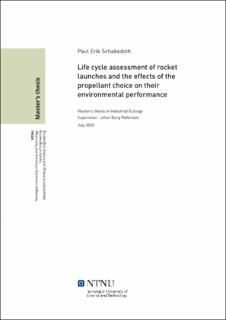| dc.description.abstract | Den første livssyklusvurderingen til for tiden brukte rakettdrivmidler ble utført. Fokuset for denne oppgaven er på den globale oppvarmingen og de stratosfæriske ozonutryddelseskategoriene. Drivstoffet bestående av usymmetrisk dimetylhydrazin og oksydasjonsmidlet dinitrogentetroksyd ble vist å være assosiert med 77,8 ± 9,2 kg CO2-ekv., Fulgt av hydrogen forbrent med flytende oksygen og RP-1 forbrent med flytende oksygen med en innvirkning på 23,7 ± 2,9 kg CO2 -ekv. og 17,3 ± 9,2 kg CO2-ekv. Flytende metan og flytende oksygen hadde den laveste virkningen på den globale oppvarmingen med 7,5 ± 1,2 kg CO2-ekv., Mens ammoniumperkloratkomposittdrivmiddelet viste seg å ha en kjølevirkning på -18,7 ± 29,3 kg CO2-ekv. Effektene av hydrogen, metan og hydrazin er drevet av energibehovet i deres produksjon på grunn av klimagassutslipp fra forbrenning av fossilt brensel. Konsekvensene av RP-1 og det faste drivstoffet domineres av utslipp under rakettoppskytingen. Svart karbonutslipp driver den globale oppvarmingseffekten av RP-1, og frigjøring av aluminiumoksydpartikler forårsaker den nedkjølende virkningen av APCP. Forbrenningen av det sammensatte drivmiddel frigjør 0,27 ± 0,18 kg CFC-11-ekv. gjennom frigjøring av klor og hydrogenklorid under lanseringen. Ozonutarmingen forårsaket av de andre drivmidlene er ubetydelig i sammenligning. Evalueringen av den globale oppvarmingseffekten forårsaket av den globale drivstoffbruken i rakettoppskytninger i 2019 viste at den er ubetydelig sammenlignet med de globale CO2-utslippene, mens utsettingene medfører 0,39% av det globale utslippet av ozonnedbrytende stoffer. Oppvarmingseffekten er i dag dominert av produksjonsprosessene til hydrazin. Når hydrazin fases ut, blir utslippene av svart karbon fra RP-1 driveren for den globale påvirkningen og optimaliseringspotensialet i miljøytelsen gjennom forbedringer av produksjonen reduseres. Bruk av metan og hydrogen bør vektlegges for å unngå vekst av begge påvirkninger. | |
| dc.description.abstract | The first life cycle assessment of the entire life cycle of currently used rocket propellants was performed. The focus of this assessment was on the global warming and stratospheric ozone depletion impact categories. The propellant consisting of unsymmetrical dimethylhydrazine and the oxidizer dinitrogen tetroxide was shown to be associated with 77.8±9.2 kg CO2-eq., followed by hydrogen combusted with liquid oxygen and RP-1 combusted with liquid oxygen with an impact of 23.7±2.9 kg CO2-eq and 17.3±9.2 kg CO2-eq., respectively. Liquid methane and liquid oxygen had the lowest global warming impact with 7.5±1.2 kg CO2-eq, while the ammonium perchlorate composite propellant was found to have a cooling impact of -18,7±29,3 kg CO2-eq. The impacts of hydrogen, methane and hydrazine are driven by the energy demand of their production due to greenhouse gas emissions from fossil fuel combustion. The impacts of RP-1 and the solid propellant are dominated by emissions during the rocket launch. Black carbon emissions drive the global warming impact of RP-1, and the release of alumina particles causes the cooling impact of APCP. The combustion of the composite propellant releases 0.27±0.18 kg CFC-11-eq. through the release of chlorine and hydrogen chloride during the launch. The ozone depletion caused by the other propellants is negligible in comparison. The assessment of the global warming impact caused by the global propellant use in rocket launches in 2019 showed that it is negligible compared to global CO2 emissions, whereas the launches cause 0,39% of the global emission of ozone depleting substances. The warming impact is currently dominated by the production processes of hydrazine. As hydrazine is phased out, the black carbon emissions from RP-1 become the driver of the global impact and the optimisation potential of the environmental performance through improvements of the production decreases. The use of methane and hydrogen should be emphasized to avoid the growth of both impacts. | |
